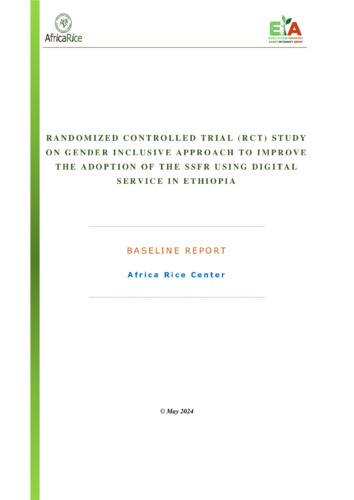Randomized controlled trial (rct) study on gender inclusive approach to improve the adoption of the SSFR using digital service in ethiopia
Abstract
This report presents the baseline survey of the Transforming Excellence in Agronomy (EiA) initiative in Ethiopia. Two regions and twelve Woredas were sampled. Data was collected using ODK software using android tablets with ONA server. A total of 1,202 wheat farmers include 44% women were surveyed during the baseline data collection. All analyses in this paper were carried out using the STATA 16 statistical software. The average age of rice farmers is 42 years old for both sexes, but women are 2 years old than men in terms of experience in wheat production. In the respondent’s sample, the average household size is 6 people, and about 94% of men are married compared to 66% of women who also have a high widowhood rate of 24%. In addition, level of education shows that over 54% of women have not received formal education versus 29% of men. In terms of main activity, 88% have crop production has main activity. However, 93 % of producers produce during the Meher season, 3% during the Belg season and 4% during both seasons. In terms of access and use of extension/advisory services in the past 12 months, 88% of farmer report having agricultural advice and 88% of this advice through the training/meeting. In addition, advice was received on time (i.e. at the right moment) in 86% of cases, and although over 80% of farmers are willing to adopt new technologies. In case of credit, 97% of them don’t have access to agricultural credit. But 57.40% them have an account with a bank or microfinance institution to save. Regarding to wheat production, wheat farmers have similar input use practices. They use about 186 kg ha-1,136 Kg ha-1, and 71 kg ha-1 for seed rate, NPK rate and Urea rate, respectively. The average yield of wheat is 2.00 t ha-1 and the yield gaps were 51% and 61% for female and for male, respectively. In relation to food security and the poverty index, preliminary results showed that the most of farmers households have an acceptable level of dietary diversity, meal frequency and nutritional importance of the food groups consumed; and the poverty index of the population remains was 38%. Finally, regarding decision-making within the household, in 28% of cases, decisions are taken jointly by men and women; on the other hand, over 49% of decisions are taken solely by men.

